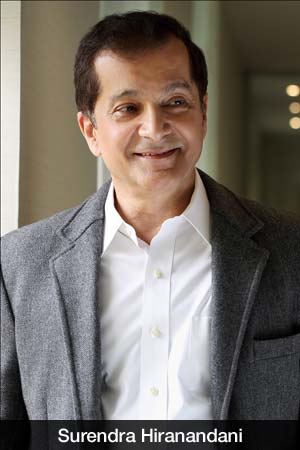Decoding the resurgence of dense, mixed use development
- 29th May 2015
- 2919
- 0

As India readies to build Smart Cities, there is a need to embrace and promote the spread of dense, mixed use development, a model adopted by several global cities like New York, London and Tokyo, feels  Surendra Hiranandani, founder & MD, House of Hiranandani.
Surendra Hiranandani, founder & MD, House of Hiranandani.
The success of a city in the 21st century is going to be determined by the human capital that it is able to attract and nurture. If Indian cities fail to provide a good quality of life to people; at some point there will be an exodus of smart people, which will be highly detrimental to the economy.
The dynamics for resurgence of dense and mixed used development can be attributed to traffic congestion, changing consumer preferences and a sense of security amongst other reasons. In denser environments, where provisions such as health, education, sports, etc are available, there will be more people in their catchment area. Construction will need to be closer to be within reach.
The per capita cost of providing infrastructure decreases as the density increases. The government and developers have embraced this concept because of its potential to reduce dependency on automobiles, promote economic development and preserve wide open spaces. Density also allows the development of high quality public transport services.
Need to embrace density:
Dense cities are vibrant economic hubs. They are not a problem but an opportunity. We must embrace density and harness it. Leading cities in the world including New York, London and Tokyo follow the dense mixed-use development pattern.
Apart from other factors, it is also the key to a safe city and many believe that this partly explains why Delhi is more unsafe than Mumbai. Dense cities that have street front retail have taken a big step in creating an automatic safety measure against crime. It is now also recognised that low density suburban development fundamentally does not allow social interaction and trends to create divisions based on income.
Practitioners and scholars recognize that current codes of development need more flexibility to create places that are  diverse, sustainable, and supportive of current trends in areas like business and technology.
diverse, sustainable, and supportive of current trends in areas like business and technology.
The newer urban developments in India like the Bandra Kurla Complex (BKC) in Mumbai, are often marked by the complete absence of fundamentals that make a great place - walkability, mixed use development and public spaces. This area has a high concentration of commercial space, so its footpaths and roads are underused after office hours and becomes deserted after a certain time, hence making the area unsafe.
Connectivity is key:
For cities to be able to grow organically connectivity must be seamless and all core areas should be pedestrian friendly. Retail shops and schools must be street facing to ensure a vibrant street life thus making it safer to walk. Additionally, parking should be public and limited within buildings.
In core areas of the city, the upper limit for car parks within buildings should be 1 car park per apartment, and commercial buildings should not have any private parking.
Big international cities like Hong Kong, Singapore, London and New York limit parking in their buildings, unlike cities like Mumbai, which require developers to excess parking lots within their projects. A normal office or residential building in these cites provides zero car parking spaces.
As the city grows, allow it to become poly-centric organically. This poly centric network should not be separated by greenbelts, which again mitigate the benefits of a dense, seamless city. Smart cities should be exempt from the National Building Code or the Code needs to be amended, as its parking requirements are as per Arabian Gulf states and American suburb standards.
These norms are unsuited models of development. It also does not allow a shopping line to touch the footpath, which is seen in all successful cities around the world.
Relax FSI restrictions:
When mixed-use residential projects are well designed, they can provide good quality housing and an active and vibrant commercial corridor. Dense cities are vibrant economic hubs which must be harnessed to the fullest.
Combine this strategy with relaxing restrictions on the supply of housing such as FSI and rent control.  Green areas should be scattered throughout the city providing safe, usable and maintainable areas for recreation rather than having large areas as greenbelts between nodes of development which act as gaskets throttling case of movement within a city.
Green areas should be scattered throughout the city providing safe, usable and maintainable areas for recreation rather than having large areas as greenbelts between nodes of development which act as gaskets throttling case of movement within a city.
Any government creating artificial restrictions on housing supply only drives up the cost of housing. This makes affordable and low income housing financially unfeasible, at least in Tier-1 cities. The Government can instead focus on monetizing the unlocked value of land and also charge premiums for high rises.
Utilize these funds to build supporting infrastructure. A minimum FSI in the central core of 2.5 is required to provide the critical mass and density for a new city.
Thus, the primary goal of mixed-use development should be to alter the current patterns of urban growth and rectify the detrimental effects on existing urban areas. The mixed use buildings should be able to achieve the objectives of an economic vitality, social equity, and environmental quality.
About the writer:
Surendra Hiranandani, is the Founder and MD of the House of Hiranandani, the leader in quality constructions and real estate development in India. He has more than 35 years of work experience in the constructions industry and is the technical and architectural genius behind the company’s reputation for quality and innovation.



Comments
Add Your Comment
Thank you, for commenting !!
Your comment is under moderation...
Keep reading other articles